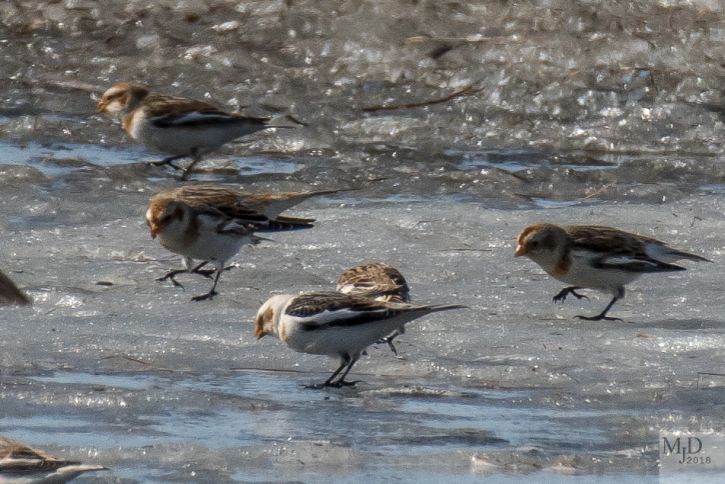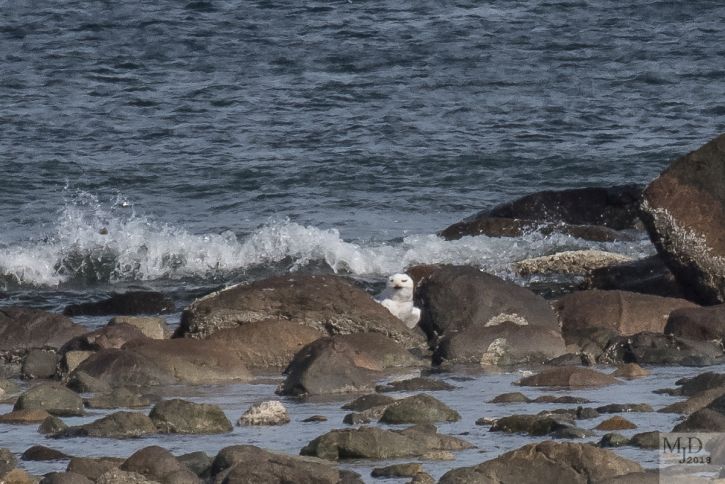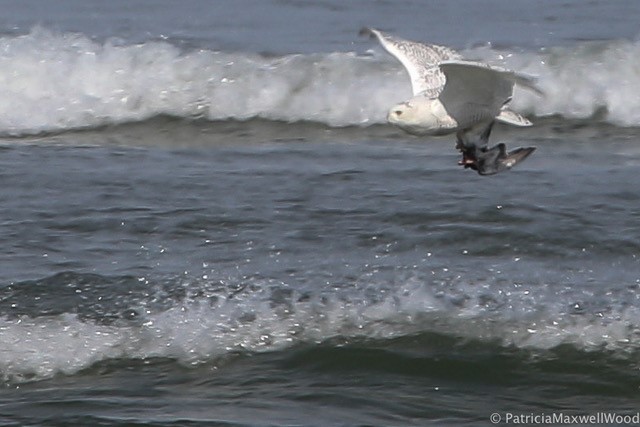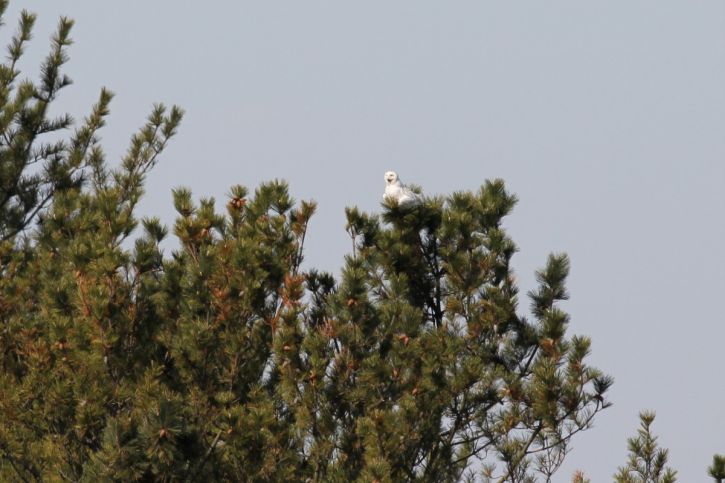Anticipating unusually warm weather and Snowy Owls as we were this past Wednesday, Dave Weaver and I were unsurprised when a large group of birders showed up at Joppa Flats. With routine sightings of three or more owls each week this winter, I’m happy to report that this week was no exception.
We heard no Red-winged Blackbirds or Carolina Wrens singing from the Joppa parking lot this week, although we have been hearing them quite regularly. At the north end of Plum Island, we stared at the beach, where at this time of year there are almost always one or two beautiful drake Common Goldeneyes foraging very near the sandy riverbank. This week we did see them, but they moved off when our group walked over. To get that perfect photo you have to be quick! A male Red-breasted Merganser hung around the entire time we were there, however, and must have had such good foraging earlier that he stayed on the surface for us to gawk at. The river/inlet was covered with scattered Common Eiders, goldeneyes, Long-tailed Ducks, and White-winged Scoters. We spotted only one Common Loon, as the months-long dearth of loons continues this winter. A Bald Eagle soared far off above the tree line that forms the horizon in Salisbury.

Red-breasted Merganser at North End – Bob Minton
Just as we returned to the vans, two Red-tailed Hawks flew up the beach and off over the river in a very un-buteo-like manner, beating their wings hard in the strong southwest breeze. They looked like they meant business to be moving north, possibly as a couple of early migrants. Driving south, we found the neighborhoods full of Rock Pigeons and Mourning Doves, along with a few LBJs, we didn’t even try to identify. As we arrived at parking lot #1 on the refuge, we encountered other birders peering intently west, a good sign for us. Way out there was our first Snowy Owl, at a distance that allowed us to see a shoulder, but not quite any eyes. Still, it was a small relief to have that taken care of. The ocean was beautiful, with clean waves slowing and rising high into the off-shore wind. It was rather empty of birds, although we did find the Black Scoters we expected off of the rock groins north of the refuge. One Surf Scoter foraged in the breakers to the south, and a few White-winged Scoters dotted the sea. On our way back to the vans our FOY Common Grackle sat hunched in the top of a tree near the gate.
Riding along the road to the south, we opened the window to see if we would hear any sounds of passerines. It was very quiet, but we did find a few bunches of Red-winged Blackbirds, which have arrived in strong numbers on the North Shore in the past week. As we pulled in to look at the few ducks that fit into the little openings in the ice in the Main Salt Panne, a big flock of much smaller things landed on the ice at the south end of the panne — Snow Buntings! The flock took off, wheeled around and returned to the spot a few times while we were there, and then was there again, pecking around on the ice after we returned from the rest of our outing. What were they finding out there?! Seeds blown onto the ice by the wind? Seeds from the guano of some roosting flock? Bits of algae stuck in the ice? We appreciated the opportunity for a new puzzle on which to conjecture. In between bouts of crushing on the buntings, we did find a brave drake Gadwall in fine plumage among the scattered American Black Ducks, staple of wintering Anseriformes in the Great Marsh.

Snow Buntings on the Main Panne – Mike Densmore
Another fine distraction while waiting for more buntings was scanning the expanse of marsh for another Snowy Owl, which we did find at not too great a distance. Somebody said that this one was some particular age or sex because of its color, very light, and I refrained from saying that you can’t do that. You can do whatever you want, really, but Mass Audubon’s Snowy Owl expert Norm Smith’s rule is “no aging or sexing Snowy Owls by the amount of pigment in the plumage!” Plumage pigmentation is not a reliable indicator, even if it is fun to see a lot of color and say, “That must be a young one – or maybe it’s a female!”

WMB at Hellcat 2-21-18 – Patti Wood
After maneuvering around all the beachgoers at parking lot #1, we should have been prepared for the crazy scene at Hellcat. There was enough movement in the parking lot to find spots for our big caravan, but barely. Then refuge personnel opened the gate to the south end, so we scooted up to the dike for a quick look at a lovely group of Northern Pintails, turned around, and high-tailed it for Emerson Rocks. Good thing! Waiting among the rocks like a sea ghost was a very maritime-looking Snowy Owl, peering at us while the tide advanced to cover its perch. Soon we discovered why the bird stayed out at sea so late in the tidal cycle, as we watched it fly in to the dunes clutching a half-eaten first-year Ring-billed Gull (best guess?), the only one of those we can say we saw that day. Add to list below – Ring-billed Gull .5? The owl disappeared into the dunes, but soon took off for a nearby grove of pines, where it sat with its mouth open for a time. While we enjoyed searching for grebes and others, the owl rested and then flew across Stage Island Pool. That was a real show! Around Emerson Rocks, we did find a pair of Horned Grebes out near many Common Eiders, Common Goldeneyes, Long-tailed Ducks, and White-winged Scoters. One Common Loon kept that tune about the loonless winter playing.

Snowy Owl peeking from among Emerson Rocks – Mike Densmore

Snowy Owl with prey from Emerson Rocks – Patti Wood

Snowy Owl in pines – John Linn
This week a lot of people came on our birding outing, many of them new. We welcome everybody, and we let them know that going birding with us, joining Mass Audubon, participating in programs, and just being out in nature makes a difference, not just for you, but for the places and creatures you love. Thanks for reading, and thanks for being part of our tribe of nature people.
Our List:
Canada Goose – common.
Gadwall (3) – pannes.
American Black Duck – common.
Mallard – a few.
Northern Pintail (11) – 8 drakes, 3 hens; Bill Forward Pool.
Common Eider – common; north end & parking lot #7 ocean.
Surf Scoter (1) – parking lot #1 ocean.
White-winged Scoter – common.
Black Scoter (7) – parking lot #1 ocean.
Long-tailed Duck (~ 25) – 13, north end; ~ 12, parking lot #7 ocean.
Common Goldeneye (~ 19) – 7, north end; ~ 12 parking lot #7 ocean.
Red-breasted Merganser (1) – north end.
Common Loon (2) – 1, north end; 1, parking lot #7 ocean.
Horned Grebe (2) – Emerson Rocks, parking lot #7 ocean.
Bald Eagle (1) – over Salisbury, from north end.
Red-tailed Hawk (5) – 2, north end; 2, vicinity parking lot #1; [1, Plum Island Tpk].
Herring Gull
Great Black-backed Gull
Rock Pigeon
Mourning Dove
Snowy Owl (3) – 1, distant in marsh w. refuge gate; 1, not as distant in marsh sw main panne; 1, in & on Emerson Rocks (!) – eventually flew with prey as tide rose.
American Crow – several.
European Starling
Snow Bunting (~ 60) – feeding on ice (!) at south end main panne.
Red-winged Blackbird (~ 12) – treetops, S-curves.
Common Grackle (1) – parking lot #1.

